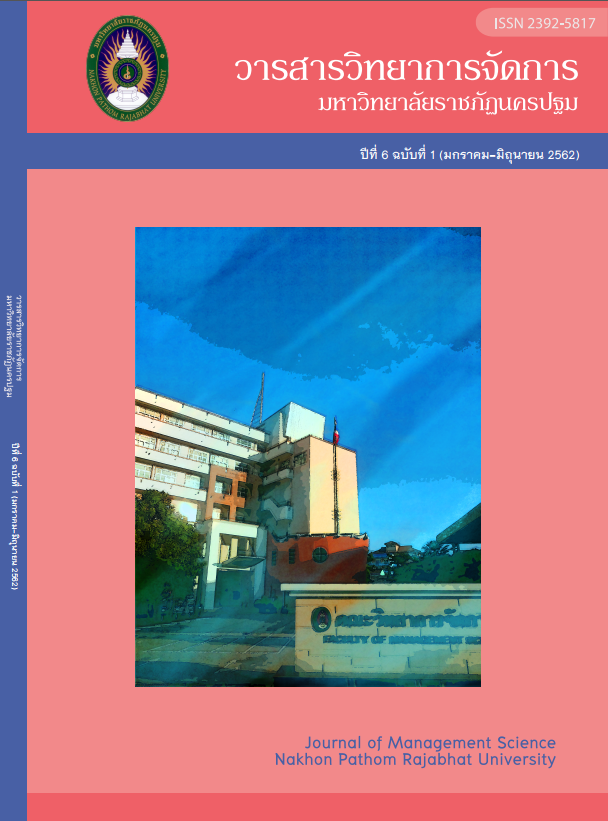The Experiential Tourism in Nakhon Pathom Province: From Tourism Resources toward Tourism’s Patterns and Activities
Main Article Content
Abstract
This research aimed 1) to explore and revise tourist attractions in Nakhon Pathom province, 2) to organize tourist activities and tourist routes for Experiential Tourism according to varied tourism resources. Areas of study include: Mueang Nakhon Pathom, Nakhon Chai Si and Sam Phran district. The research method used by interviewed 50 tourism stakeholders with purposive sampling and the questionnaire was used by 400 Thai tourists with convenience sample. The data obtained from the questionnaire were analyzed by frequency, percentage, mean, and standard deviation. In the interview section, use content analysis.
The results were as follows, there were 4 types of tourist attractions in Nakhon Pathom which consisted of agricultural tourist attractions, historical and cultural tourist attractions, religious and beliefs tourist attractions and wellness tourist attractions. Moreover, from a survey of tourist’s attitudes, behaviors and satisfactions, it showed that tourists expected tourist attractions. Furthermore, some factors motivated them to decision to travel which were tourist attractions and activities. Also, they satisfied with attractions, activities, and experiences factors. Consequently, the research findings were analyzed by the outputs of varied tourism resources and the tourist’s behavior and satisfaction that could organize 4 types of tourism and 5 Experiential Tourism routes as: 1) Religious and Beliefs Experiential Tourism 2) Agricultural Experiential Tourism 3) Historical and Cultural Experiential Tourism and 4) Wellness Experiential Tourism. For 5 Experiential tourism routes as: 1) Religious and Beliefs on Pilgrimage journey 2) Historical, Cultural and Sufficiency Economy in Dvaravati territory; 3) Learning farmer lifestyle, Integrated farming for Experiential Tourism; 4) Wellness Experiential Tourism with natural therapy way and 5) Wellness Experiential Tourism with sufficient economy way.
Article history : Received 1 August 2018
Revised 14 August 2018
Accepted 22 August 2018
SIMILARITY INDEX = 0.00
Article Details
The views and opinions of the article appearing in this journal are those of the author. It is not considered a view and responsibility of the editorial staff.
References
กระทรวงการท่องเที่ยวและกีฬา. (2558). แผนพัฒนาการท่องเที่ยวแห่งชาติ พ.ศ. 2555 – 2559. [ออนไลน์]. ค้นเมื่อ 4 ตุลาคม 2558.จาก https:// www.mots.go.th/ewt_dl_link.php?nid=4147
ฉันทัช วรรณถนอม. (2552). อุตสาหกรรมการท่องเที่ยว. กรุงเทพฯ : สามลดา.
เทิดชาย ช่วยบำรุง. (2552). บทบาทขององค์กรปกครองส่วนท้องถิ่นกับการพัฒนาการท่องเที่ยวอย่างยั่งยืนบนฐานแนวคิดเศรษฐกิจพอเพียง. กรุงเทพฯ : สำนักพิมพ์คณะรัฐมนตรีและราชกิจจานุเบกษา
เทพกร ณ สงขลา. (2556). รูปแบบการจัดการทรัพยากรเกษตรเพื่อการท่องเที่ยวเชิงเกษตรที่ยั่งยืนในอำเภอช้างกลาง จังหวัด นครศรีธรรมราช. สงขลา : มหาวิทยาลัยสงขลานครินทร์
นิพล เชื้อเมืองพาน. (2556). การวิจัยเชิงปฏิบัติการแบบมีส่วนร่วมของชุมชนเพื่อพัฒนาการท่องเที่ยวแหล่งน้ำพุร้อนในภาคตะวันตกของประเทศไทย. กรุงเทพฯ : สถาบันวิจัยและพัฒนาแห่งมหาวิทยาลัยเกษตรศาสตร์.
วารัชต์ มัธยมบุรุษ. (2554). ส่วนประสมตลาดการท่องเที่ยวพำนักระยะยาวสำหรับนักท่องเที่ยวชาวญี่ปุ่นที่พำนักระยะยาวในจังหวัดเชียงใหม่.วารสารมหาวิทยาลัยนเรศวร: วิทยาศาสตร์และเทคโนโลยี. 19 (พิเศษ), 80-88.
สำนักพัฒนาการท่องเที่ยว. (2557). คู่มือประเมินมาตรฐานคุณภาพแหล่งท่องเที่ยวเชิงเกษตร. กรุงเทพฯ : กระทรวงการท่องเที่ยวและกีฬา.
สำนักงานจังหวัดนครปฐม.(2560). บรรยายสรุปจังหวัดนครปฐมปี 2560. [ออนไลน์]. ค้นเมื่อ 15 กันยายน 2560 จาก https://www.nakhonpathom.go.th
Cohen, E. (1979). A Phenomenology of Tourist Experience. Sociology. 13, 179-201.
Fuggle, L. (2016).The Rise of Experiential Travel and Its Impact on Tours and Activities. Retrieved October 4, 2017, from https://www.trekksoft.com/en/blog/rise-of- Experiential-travel
Dowling, R.K. (2002). Australian Ecotourism – Leading the Way. Journal of Ecotourism 1, (2-3) Retrieved October 4, 2017, from https://www.tandfonline.com/
Smith, W,L. (2005). Experiential Tourism around the World and at Home: Definitions and Standards. Kansas: Emporia State University.
Yamane, T. (1973). Statistics an Introductory Analysis. (3rd ed.).New York: Harper and Row.


